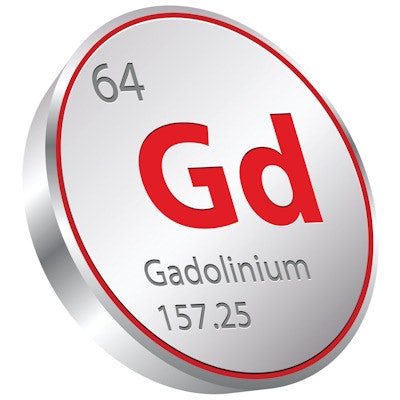
The U.K. Royal College of Radiologists (RCR) has updated its guidance on the administration of gadolinium-based contrast agents (GBCAs) to adult patients. The 23-page document addresses concerns about possible long-term gadolinium retention in the brain and the risk of nephrogenic systemic fibrosis.
 Dr. Giles Roditi from the University of Glasgow, who drafted the guidance.
Dr. Giles Roditi from the University of Glasgow, who drafted the guidance.The report includes eight key recommendations to support practitioners using GBCAs in the treatment of their patients and covers safety, prescribing, consent, identification of patients at increased risk from contrast administration, and pregnancy and lactation. There is also advice on the management and treatment of acute reactions.
"The potential and theoretical risks of intravenous administration of GBCAs for MRI must be weighed against the potential benefits to the patient. (It should be noted that GBCAs are not approved for intra-arterial injections or enhancement of radiographic examinations such as invasive arteriography.) Withholding contrast for MRI may deprive patients of the benefits of valuable diagnostic information or necessary therapy," the authors wrote.
GBCAs are associated with a very low rate of immediate adverse events (0.06%-0.09%), and most adverse events are mild and can be managed in the radiology department, they continued.
"Major life-threatening contrast reactions to GBCAs are extremely rare. The incidence of acute, severe reactions is estimated to be 0.0025-0.005%," the authors wrote. "To minimize risk, it is important to identify individuals at an increased risk of an adverse event. Appropriate steps should always be taken to reduce the risk of contrast reactions."
The main recommendations are as follows:
- An individual trained in recognizing and treating severe contrast reactions, including anaphylaxis, should be immediately available for the department where intravenous contrast is administered.
- A formal record of the decision to inject contrast should be made before administration.
- The individual administering the contrast must check that there are no contraindications to its use and ensure that the patient understands that it is to be given and agrees to the procedure.
- In cases where there is a previously reported moderately severe or severe reaction to contrast, caution should be exercised and the need for contrast should be re-examined with respect to an unenhanced study or other potential methods of investigation.
- For elective examinations in patients who have a history of previous contrast reactions, referral to a specialist drug allergy service should be considered for assessment and testing against a panel of contrast compounds to determine the safety of administration.
- The dose of GBCA should be minimized, taking into consideration the indication, the patient's body weight, and the information from the manufacturer contained in the summary of product characteristics. The dose administered should be recorded electronically for audit purposes.
- When using GBCAs, knowledge of the patient's renal functional status is generally advisable. GBCAs should be used with caution in patients with severe chronic or acute renal impairment, in patients in the perioperative liver transplantation period, and in neonates.
- Significant suspected contrast reactions should be formally documented with full details, investigated appropriately with advice given to the patient, and referral made to a specialist drug allergy service to help guide future management.
To ensure safety, systems must be in place to call an appropriately trained doctor who can deal immediately with a severe contrast reaction. If required, this may include a crash team, the authors stated.
"In the presence of risk factors, the decision about contrast administration should only be taken by the radiologist responsible for the procedure. This decision process should include the location of the proposed examination with reference to resuscitation capability," they added.
A patient should not be left alone or unsupervised in the first five minutes after an injection of any intravascular contrast, and the patient should remain on the premises for at least 15 minutes following the injection because most severe reactions occur during this time. For patients identified as having an increased risk of reaction, this time period should be increased to 30 minutes following the injection. All contrast reactions, with details of their nature, severity, and the specific compound used, should be included in the radiological report and updated in the patient's hospital notes and on the RIS, the authors wrote.
In her foreword, Dr. Caroline Rubin, RCR's vice president of clinical radiology, paid tribute to Dr. Giles Roditi, a consultant radiologist at Glasgow Royal Infirmary and honorary associate professor at the University of Glasgow, for drafting this guidance and providing expert advice to the Medicines and Healthcare products Regulatory Agency.
This guidance replaces the previous guidance on GBCAs and nephrogenic systemic fibrosis and standards for intravascular contrast administration in adult patients (third edition), which have now been archived, she noted. Also, the RCR endorses the Royal Australian and New Zealand College of Radiologists' 2016 Iodinated Contrast Media Guideline, which can be viewed online and should be used alongside this document.
You can download the full document free of charge from the RCR website.



















